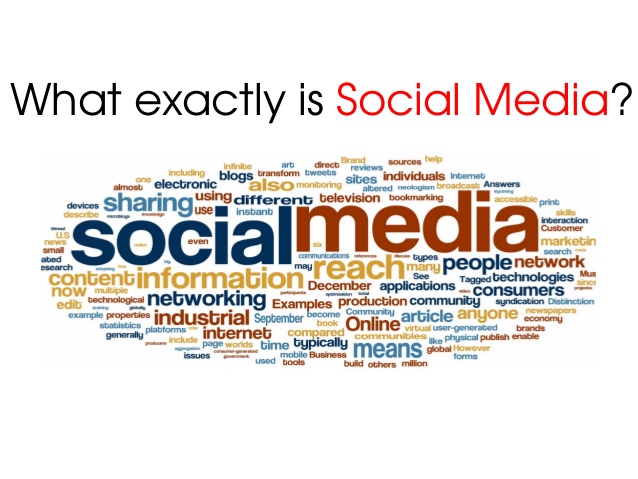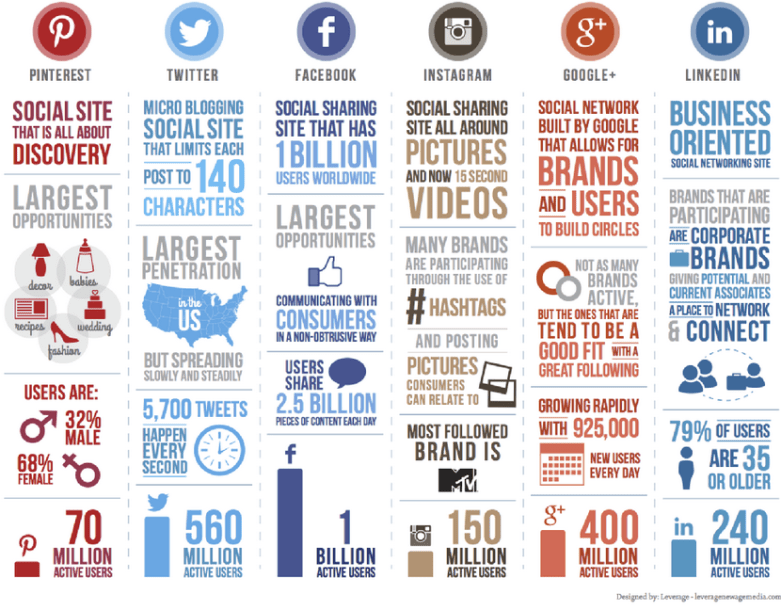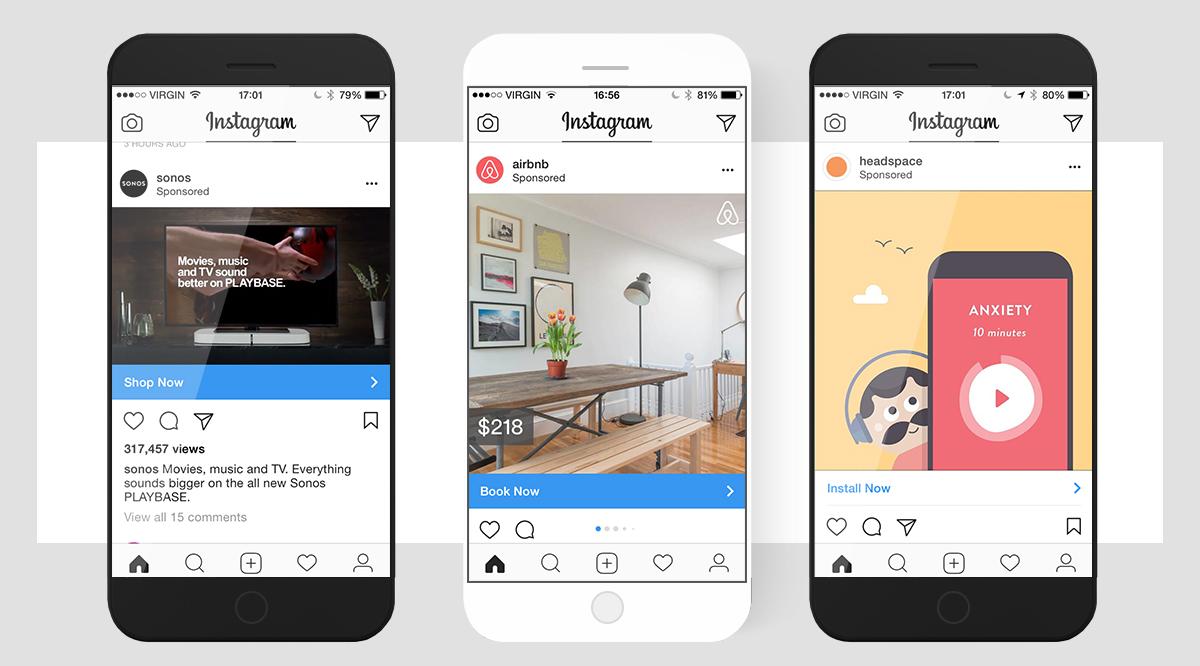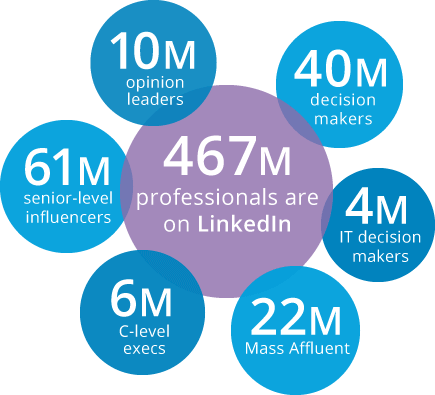Have you recently heard of advertising through social media? Or do you need to sharpen your knowledge on the subject? In our beginner’s guide on advertising through social media, we will share basic information on the subject, as well as tell us about working as an online marketers.

Content
Chapter 1: What are social media?
Chapter 2: Facebook Advertising
Chapter 3: Instagram Advertising
Chapter 4: LinkedIn Advertising
Chapter 5: Get started with live streaming
Chapter 6: Work as Online Marketers
Chapter 1: What is social media?
With social media, we mean sites or apps where content is created by users. Content can consist of all possible – interesting links, discussions and information about hobbies, current topics, personal opinions and insights.

Social media are also used by companies and organisations in different ways. Some focus on advertising (which involves digital marketing ), others on building and strengthening contact with their customers. A lot of companies have also chosen to outsource parts of their customer service in social media.
How and what a company or organisation should do in social media depends entirely on what the core business is and what its customers are. The basic rule, however, is that you should be in social media if your customers do.
Work with social media
The great advantage of social media and search marketing (SEM) is that they make it easier to reach specific target groups – provided that they have a well-thought-out strategy. The strategy should include some of the following:
Advertising – Today it is possible to advertise in most digital channels – Facebook, Instagram, LinkedIn and Twitter, which is also commonly referred to as digital marketing. The advantage of advertising in social media is that it is relatively easy to reach specific customer groups based on their age, geographical area, interests or behaviour. This makes it much easier to reach them with customised messages to them. With that in mind, it’s time to think about what the purpose of advertising is. It may be to find new customers, strengthen the brand, drive traffic to the web site, or create a more personal contact with the customers. Once you’ve started advertising, it’s easy to measure the results of it and optimise it further if necessary.
Interacting and analysing – Social media is an excellent way to communicate with its customers. Both by sharing your own story, quickly reaching out with information that the telephone exchange is not working right now, or, in the worst case, defending and declaring itself in a crisis.
The strategic moments should include a plan about where to update, as well as what frequency. A crisis management plan is also important to work out, to counter Olle in gravel.
We also want a slight blow because social media is a great way for you to work around the world, and what happens in your own industry, but also how the “snapper goes” more generally. Based on that, you can then create trends, track trends, more easily understand their customers, or just find new ones.
Which Social media channel suits for you?

Chapter 2: Facebook Advertising
Facebook is the social media with the absolute most users. In Australia, there are about 5.9 million, ranging from CEOs to students. The average Facebook user uses the platform 14 times a day, so it’s no wonder that many companies want to advertise on Facebook.

Advertise on Facebook tips
To be successful in advertising on Facebook, there are some things that are important to keep in mind. The main thing is to create optimized ads that target a specific audience. These ads should contain the following four components to be successful:
- They are visual. For a long time, photos and movies have taken over Facebook. It’s not enough to write an insane text, it must be visual as well. Facebook’s algorithm also prioritizes posts with images and the likelihood that they are shared increases.
- They are relevant. In order for your ad to be successful, it must feel relevant to the target audience. Otherwise, you will waste both your own time and money, but also users. You pay for each click and want it to be a person with a genuine curiosity on your product. The right audience is achieved by using the ad settings in a thoughtful and strategic way. Even Facebook measures and prefers relevant ads that are appreciated by users.
- They contain an attractive proposal. Which is what then causes the user to click on the ad. Please answer the question “Why should the user click on your ad?” Well, then they will receive a 10 percent discount on new shoes, for example.
- A clear call-to-action (CTA) call. After seeing the ad, it’s important that the user understands what to do, whether they choose to do it or not. It may also be helpful to time the action; “Buy Now” or “Offer Ends Soon”, so that the user clicks your ad at once.
Other tips and tips on marketing on Facebook
For businesses wishing to use Facebook as a marketing channel, we usually recommend doing it properly and professionally from the start. The page on Facebook should keep up to date and it should not be a static page similar to your website. Do not forget that your Facebook page will be a reflection of your business. If your company makes the choice to use a Facebook page, be sure to do it properly from the start.
A method of creating interest in Facebook for your business is to organize competitions or end gifts. Giving away a desirable product makes people happy and it also creates motivation for the visitor. The motivation makes the visitor take the call as you would like the visitor to do. For example. if you want the visitor to like your page. Why should I like your side if I do not get any of you? However, it does not always have to be a gift. Sharing knowledge can be equally worthwhile for the visitor. Sometimes it may be enough to actually ask or kindly ask the reader to share the post.
It’s always good to announce any winners on your Facebook page. Repeat the strategy each time to streamline the flow of new followers or subscribers. It also shows a transparency towards future contestants where you see with your own eyes that you actually give out a gift to the people who win.
Try to make your Facebook page memorable for the visitor. The visitor should feel the same red thread whether you are on your website or Facebook page.
Facebook is a channel where you share things. Therefore, it is important that you communicate with a professional tone. What if your share is shared? It can spread to both existing customers and potential customers. Post blog posts and promote your blog posts via channels other than your Facebook page. It will increase your traffic and profit in the long run.
Have you set a strategy for your social media? Do you know what your company should convey if you get a negative review? What does action take? How fast will you respond? How often do you update the page? What are your goals?
Chapter 3: Instagram Advertising

Most social channels are free of charge at the beginning but as users increase, the more interesting they become as the ad space for companies. By the end of 2015, it became possible for companies to advertise on Instagram in Australia and since then the ads have become more common.
Advertising on Instagram differs from advertising on Facebook or Twitter. The interaction with sponsored posts on Instagram is often higher and goes faster than most other channels. It’s probably because Instagram is image and movie based from the very beginning. The users are therefore used to seeing pictures and to quickly decide if they like them or not. According to studies, users also remember Instagram ads more easily than they remember advertising in other social channels.
Instagram users are also more likely to stay on one page once they have proceeded from an ad. On average, they stay 192 seconds longer than Twitter and Facebook users.
Obviously, Instagram makes it a very interesting advertising platform. However, to succeed, it is important to understand and customize their ads according to Instagram’s format.
Some things to keep in mind about Instagram advertising:
The most important thing to understand with Instagram is that it is primarily used on the mobile phone, so you design your ad after that. It is also important that the ads are not disturbing to the users. They will melt into the flow, as if sponsored posts came from someone they follow.
Just like when you advertise on Facebook, you can clearly choose your audience so your campaign reaches the right audience – based on a specific location, demographics, interests, and more.
So what does an ad cost on Instagram?
It depends on how you choose to post the campaign. You can choose to pay per impression (CPM), per click (CPC), per engagement (CPE) or per app install (CPAI).
Another interesting feature of Instagram is that users can donate money, which should be particularly interesting for associations.
Finally
If your target audience is on Instagram then it’s one of the best social channels for advertising, thus not saying it suits all businesses.
Chapter 4: LinkedIn Advertising
Spontaneously, LinkedIn feels like the ideal advertising site for B2B marketing. Partly because it’s a channel for people as their professional self. At the same time, we must not forget that even workers have privacy, own interests and needs.

Some interesting facts about LinkedIn:
- LinkedIn was founded in late 2002 and was listed in 2011
- LinkedIn has over 475 million users in 200 countries
- LinkedIn has offices in 30 cities around the world, in Australia they opened an office in 2011
- Gender segregation between users is 44 percent women and 56 percent men
- 40 of the users log in daily
- In Australia there are 35,000 company pages
- In Australia there are about 2.6 million users, plus 200,000 Aussies outside Australia
- 70 percent use Linkedin when they are at work
- 13 percent of LinkedIn users have no Facebook account
- 59 percent of users never visit Twitter
- 88 percent of marketers who work with B2B use LinkedIn
- 47 percent of all Linkedin visitors use the app in their mobile
- 40 percent of users use the app to search for jobs
Benefits
The advantage of advertising on LinkedIn is that by targeting your campaign to specific industries and occupational roles, you can reach your target audience in a more accurate way. That way, LinkedIn differs from Facebook, where you often discern and find your audience based on completely different parameters, interests, groups, age, and more. Because many LinkedIn users fill in completely different information, the possibilities will be different.
Here are some of the filters that you can use for your LinkedIn advertising:
- Company size
- industry
- Title and position
- Geography
- groups
Cons and conclusion
LinkedIn has been criticized for its advertising solution where the payment model makes budgeting difficult. For example, the price per click is not specified in advance. Compared to most other platforms, it is also expensive per click. This makes it best suited for larger B2B companies with a larger budget and a clearly defined target group.
Chapter 5: Get started with live streaming
A few years ago, there were many parents who put the coffee, tea or milk in the whirlpool when they were told what children and young people did at Periscope. Hets, clenched, fill and sex.
But live videos are so much more than that. Especially in these times when we are increasingly exposed to false news and over-manipulated material from doubtful sources. That’s why the future is in live streaming with real people – right from a mobile to your fans, customers and other curious ones.
Here are some tips and things to keep in mind:
1. Select platform. Today there are a host of applications that you can broadcast live with. Which one you choose should depend on where your audience is. In order to arrive at that I propose some honest research and lurking. Read, create accounts and check out how the different applications work. Some suggestions on where to start are on Periscope, Facebook Live, YouTube Live and now most recently with Twitter.
2. Explain what you have to show up and tell about. After you’ve seen what others are doing, you’ve probably got a lot of inspiration for your own content. Brainstorm, write down and build up. Always make sure you have a plan for your broadcasts – something to tell or show up.
3. A live stream should be at least ten minutes long. But do not worry if they are filled with good content and you are clear in the presentation of it and others will find you. The viewers will also have questions and comments and suddenly you have sent in 45 minutes instead of ten.
4. Some suggestions on what your content may consist of are:
“If you work on a public or non-profit business, you are probably organizing lectures and seminars at times. It is perfect for live streaming.
– A format I like is “Ask me – I’m an expert on …” (depending on what your business is about) and do not think people are not interested in what you do. Looking at how someone drops a tree, informs how insurance rules work or send live once a week from a building is interesting.
5. Send regularly and inform the followers you already have about the shipping time before, so they can find you.
6. Also, do not forget to invite viewers to follow you at the end of the broadcast so that they do not miss the next broadcast.
Chapter 6: Work as Online Marketers
The landscape for what people doing with marketing do have changed rapidly since the internet became a new tool and field of work. It has also led to a lot of new education and titles. One of the more common is online marketers, but what does the profession really mean?
Work as an online marketer is flexible and combines strategic and analytical tasks with more concrete tasks. Among other things, it is about gaining an understanding of how different digital channels work, as well as keeping in mind how they change and develop. It’s fast sometimes and the online marketers must be able to keep up with the turns to understand which channels work best. How they can be integrated with the messages you want to reach is also important.
As an online marketing engineer, you also include more technical tasks – to enable search engine optimisation, advertising on search engines and social media, managing images, writing, filling pages and feeds with relevant content (content) as well as some programming.
Psychology and analysis are other important things that an online marketers must be able to master. This applies partly when monitoring and evaluating different marketing measures, campaigns and traffic. This also applies when designing a webpage or when building and launching a campaign. It is then important to understand both your own message and the needs and the driving forces of the target group to match and meet each other.
To drive traffic and create conversions
This is often the online market leader’s main goal no matter what project they are working for. Driving traffic I think most people know, but creating conversions is something more complicated. Therefore, online marketers are working with conversion optimisation.
Conversion optimisation basically means getting more visitors to buy a product or service from you. Let’s say you have 2,000 visitors to your site today, but only 100 of them are shopping. Conversion Optimiser focuses on increasing the number in the last group. Most often, it is done through different tests, which again analyses what works best.
As I initially talked about, the job as online marketers is very flexible. The landscape, tools, people’s habits and behaviour change all the time. It is also what makes the work both dynamic and exciting.
Finally,
Congratulations! You have now reviewed our new guide to social media advertising. You should therefore have basic knowledge of the subject, as well as know how to work as an online market driver. We also hope that you will use some of the tips we shared with you to take your ads to the next level!


